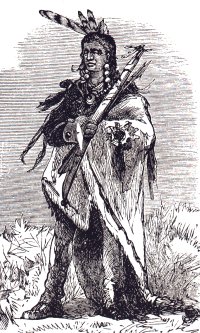

Born in 1720 in what is now northern Ohio, Pontiac rose to a position of prominence among his people the Ottawa. He was a fearsome warrior who identified strongly with the French. At the conclusion of the French and Indian War, Pontiac was not ready to accept English rule over Indian lands. He considered the British to be both arrogant and presumptuous. He was, of course, correct.
In order to oust the British from the Great Lakes country, Pontiac formed an alliance of tribes from all over the region. These included his Ottawas, the Chippewa, the Miami, the Fox, the Wyandots, and others. If the Illini were present at the beginning, they were not present in great numbers. Each nation was to rise simultaneously against the British post in their own country. Pontiac himself would lead the attack on Fort Detroit. The Chippewa would rise against the British at Michillimacinac. Others would rise against the forts at Presque Isle, St. Joseph, Miami, and Edward Augustus. All would strike when Pontiac gave the word.
The uprising came off as planned. All of the smaller forts were captured or surrendered. Only Detroit held out. According to legend, Major Gladwin had been warned by someone of the coming attack. There has been much speculation about who warned the commander but most sources point to Catherine, a Native-American woman. Others suggest Jacques Duperon Baby, one of the Frenchmen in Pontiac's confidence. Whoever warned Gladwin, he had the good sense to heed it. Pontiac's surprise attack (with guns sawed off and hidden under women?s clothes) was frustrated. The Indian coalition settled in for a siege.
As history records, the British outlasted the Indians. Although Pontiac sent messengers to Fort de Chartres in the Illinois Country and emplored the French to come to his aid, de Villiers, in recognition of the Treaty of Paris, refused to come. Perhaps a few Illini warriors joined in the siege but they did not have a meaningful military presence at Detroit. In time, groups of warriors drifted away until at last the siege was ended. In 1766, Pontiac made peace with the British. This caused a great deal of anger among the Illini, because of their attachment to the French, and the Kickapoo, because of their hatred of the British. The Illinois position was certainly questionable, given that they had not supported Pontiac at Detroit in any meaningful way. Later in council, Pontiac reputedly quarreled with Matachinga, a Peoria Chief whose name means "Black Dog" and stabbed him, although not fatally. Even some Ottawa openly defied Pontiac. Pontiac's star was at its nadir.
Pontiac's dream of an Indian confederation that would oust the British from Indian lands did not die at Detroit. Still considering himself loyal to the French, Pontiac went among the Illinois, themselves French allies of long-standing. Perhaps there he would find men with hearts similar to his own who would join him in his fight against the British. Perhaps the differences between the Ottawa and the Illini could be set aside to concentrate on the struggle against the common enemy, the British.
In
1769, Pontiac was in Cahokia, the busy village of the Cahokia tribe of the
Illini Confederation. The village now had a British trading post rather than a
French store. The Union Jack, rather than the Fleur de Lys, flew over that post.
Under the noses of the British, Pontiac would meet with the Illinois and perhaps
things this time would work out better.
